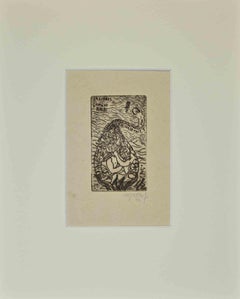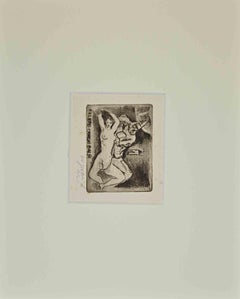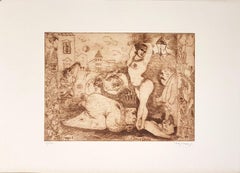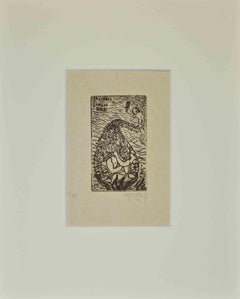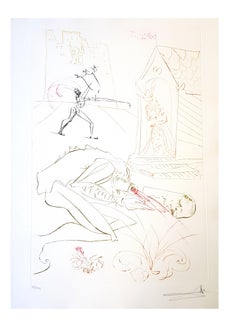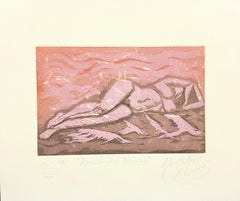Franco Rognoni Art
to
3
4
4
4
1
1
Ex Libris Giorgio Balbi - Woodcut - 1944
By Franco Rognoni
Located in Roma, IT
Ex Libris For Giorgio balbi, realized by Franco Rognoni
It includes passepartout, 30 x 24 cm.
Hand signed and dated on the lower margin.
Good conditions.
Category
Mid-20th Century Modern Franco Rognoni Art
Materials
Paper, Woodcut
$205 Sale Price
30% Off
Ex Libris Giorgio Balbi - Woodcut - Mid-20th Century
By Franco Rognoni
Located in Roma, IT
Ex Libris Giorgio Balbi is an artwork realized by Franco Rognoni, in 1942.
Etching, 9 x 10 cm; It includes passepartout 24 x 30 cm.
Handsigned and dated bottom right.
Good condit...
Category
1940s Modern Franco Rognoni Art
Materials
Paper, Woodcut
$205 Sale Price
30% Off
La Bella Otero - Origina Etching by F. Rognoni - 1951
By Franco Rognoni
Located in Roma, IT
Amusing etching, representing the seducing Spanish dancer, Carolina Otero.
Numbered and hand-signed with pencil on lower margin by the Italian artist, Franco Rognoni. Edition of 25 ...
Category
1950s Franco Rognoni Art
Materials
Etching
Ex Libris Giorgio Balbi - Etching - Mid-20th Century
By Franco Rognoni
Located in Roma, IT
Ex Libris For Giorgio Balbi, realized by an artist of the mid-20th Century.
It includes passepartout, 30 x 24 cm.
Hand signed on the lower margin.
Good conditions.
Category
Mid-20th Century Modern Franco Rognoni Art
Materials
Paper, Woodcut
$229 Sale Price
30% Off
Related Items
Salvador Dali - Fight Before la Dame - Original Handsigned Etching
By Salvador Dalí
Located in Collonge Bellerive, Geneve, CH
Salvador Dali - Original Handsigned Etching
From La Quête du Graal
Dimensions: 45 x 33 cm
Handsigned
Edition: 38/100
(from the rare deluxe suite aside from the standard edition)
Cat...
Category
1970s Surrealist Franco Rognoni Art
Materials
Etching
$1,875
H 17.72 in W 13 in D 0.4 in
"Discovering your landscapes" 2007 Original Engraving Signed Figurative 12x10in
Located in Miami, FL
Alberto"El Cuervo" Bustillos (Mexico, 1950)
'Descubrir tus paisajes', 2007
etching, aquatint on paper Deponte 300 g.
12.3 x 10.3 in. (31 x 26 cm.)
ID: CUR-108
Unframed
Category
Early 2000s Contemporary Franco Rognoni Art
Materials
Etching, Aquatint, Engraving
John Taylor Arms, Study in Stone, Cathedral of Ourense
By John Taylor Arms
Located in New York, NY
John Taylor Arms was known for making such finely drawn etchings that commercial tools were not good enough: He regularly used sewing needles with corks ...
Category
Mid-20th Century American Realist Franco Rognoni Art
Materials
Etching
3 Jewish Men Judaica Woodblock Woodcut Engraving Print Chicago 1930s WPA Artist
By Todros Geller
Located in Surfside, FL
Todros Geller (1889 – 1949) was a Jewish American artist and teacher best known as a master printmaker and a leading artist among Chicago’s art community.Geller was born in Vinnytsia, the Russian Empire (now Ukraine) in 1889.[2] He studied art in Odessa and continued his studies after moving to Montreal in 1906 where he immigrated to Canada. He married and moved to Chicago in 1918, where he studied at the School of the Art Institute of Chicago until 1923.
Geller produced paintings, woodcuts, woodcarvings, and etchings. His work focused on Jewish tradition, often including moralistic themes and social commentary, shtetl, ghetto life, and the intersection of Jewish tradition with modern-day Chicago. He regarded art as a tool for social reform and he spent a large part of his career teaching art. His work was commissioned for stained glass windows, bookplates, community centers and Yiddish and English books. He was regarded as a leader in the field of synagogue and religious art. He designed stained glass window for synagogues in Omaha, Fort Worth, Dayton, Stamford, and Chicago Heights. Over the course of his career he illustrated more than 40 books.
In addition to conducting classes in his studio, Geller was head of art at the Jewish People’s Institute (JPI), supervisor of art for the Board of Jewish Education and director of art for the College of Jewish Studies (which became the Spertus Institute for Jewish Learning and Leadership) and taught at Hull House. Many prominent Chicago artists studied drawing and painting under Geller. Geller was a source of inspiration to Aaron Bohrod and Mitchell Siporin...
Category
Early 20th Century Modern Franco Rognoni Art
Materials
Paper, Woodcut
Wedding Party
Located in Buffalo, NY
An original mid century modern woodblock print.
This work is hand signed illegibly and titled "Wedding Party".
Category
1960s Modern Franco Rognoni Art
Materials
Paper, Woodcut
THE WAGON SHOP
By Gustave Baumann
Located in Santa Monica, CA
GUSTAVE BAUMANN (1881 – 1971)
THE WAGON SHOP, 1910 (Chamberlain 24)
Color woodcut signed in pencil. Unnumbed from an edition 100 as published in the Hills o’ Brown...
Category
1910s Modern Franco Rognoni Art
Materials
Woodcut
"Lady Holding a Baby" - Woodblock Print on Laid Rice Paper
Located in Soquel, CA
"Lady Holding a Baby" - Woodblock Print on Laid Rice Paper
Elegant woodcut print by Stephen White (American, b. 1939). In an early example of White's signature style, a stylized, mi...
Category
1970s Modern Franco Rognoni Art
Materials
Rice Paper, Woodcut
$1,700
H 32 in W 24 in D 0.25 in
Jonah
By Sadao Watanabe
Located in Santa Monica, CA
SADAO WATANABE (Japanese 1913-1996)
JONAH, 1959
Color stencil, signed, numbered and dated in white ink. Sheet, 25 5/8 x 22 5/8 inches. Edition: 44/50. Good color and generally good ...
Category
1950s Modern Franco Rognoni Art
Materials
Woodcut, Stencil
'The Rabbit' original woodcut engraving by Clarice George Logan
By Clarice George Logan
Located in Milwaukee, WI
In 'The Rabbit,' Wisconsin artist Clarice George Logan presents the viewer with a multi-figural scene: under a wood-frame structure, four children crouch on the ground, gathered around a young woman who presents a rabbit. Under normal circumstances, such an image of children with a bunny would recall childhood storybooks. In this case, however, the image is more ambiguous and suggests the unfortunate economic circumstances many children suffered during the interwar years. Nonetheless, the group could also be interpreted as a nativity play, with the rabbit taking the place of the Christ child, shining light on the children like in a painting by the Italian Renaissance artist Correggio. The careful line-work of the woodblock engraving adds a sense of expressionism to the scene, leaving the figures looking distraught and dirty, though the image nonetheless falls into the Social Realist category that dominated American artists during the Great Depression.
This print was published in 1936 as part of the Wisconsin Artists' Calendar for the year 1937, which included 52 original, hand-made prints - one for each week of the year.
Clarice George Logan was born in Mayville, New York in 1909 but moved to Wisconsin in 1921. She attended the Milwaukee State Teachers College from 1927 to 1931 where she studied with Robert von...
Category
1930s American Modern Franco Rognoni Art
Materials
Engraving, Woodcut
$1,300
H 12.37 in W 14.43 in
EARLY JACOULET - A DOWNPOUR AT METALANIM PONOPE EAST CAROLINAS
By Paul Jacoulet
Located in Santa Monica, CA
EARLY JACOULET
PAUL JACOULET (1896 – 1960)
UNE AVERSEA METALANIM, PONAPE , EST CAROLINES, 1935
A DOWNPOUR AT METALANIM PONOPE EAT CAROLINAS (Miles 29)
Color woodcut, with metallic ...
Category
1930s Modern Franco Rognoni Art
Materials
Color, Woodcut
$1,500
H 15.5 in W 11.75 in
Salvador Dali - Woman Holding a Veil - Original Stamp-Signed Etching
By Salvador Dalí
Located in Collonge Bellerive, Geneve, CH
Salvador Dali - Woman Holding a Veil - Original Stamp-Signed Etching
Stamp signed by Dali
Edition of 294 copies.
Edition number : 7
Paper : Arches vellum.
Dimensions : 16x12".
Cat...
Category
1960s Surrealist Franco Rognoni Art
Materials
Etching
$1,758
H 16 in W 12 in D 0.1 in
The New Pupil /// Antique Modern Female Artist Etching Child Children Figurative
By Eileen Soper
Located in Saint Augustine, FL
Artist: Eileen Alice Soper (English, 1905-1990)
Title: "The New Pupil"
*Signed by Soper in pencil lower right
Year: 1925
Medium: Original Etching on unbranded white wove paper
Limite...
Category
1920s Modern Franco Rognoni Art
Materials
Etching, Intaglio
Previously Available Items
Passersby 1993
By Franco Rognoni
Located in Milan, IT
Mixed technique on canvas. Signed lower right. Back has art gallery label with artwork details and price; also present is MiArt participation label 2008.
The work belongs to Franco ...
Category
20th Century Contemporary Franco Rognoni Art
Materials
Mixed Media
Figures
By Franco Rognoni
Located in Milan, IT
Oil on Canvas. Signed lower right.
The work belongs to Franco Rognoni's second period, in which he recovered from the existential crisis that had turned him away from easel painting...
Category
20th Century Contemporary Franco Rognoni Art
Materials
Oil
Troubadour - Drawing by Franco Rognoni - 1970s
By Franco Rognoni
Located in Roma, IT
Troubadour is an original modern artwork realized by Franco Rognoni (1913-1999) in the 1970s.
Black and white china ink drawing on paper.
Hand ...
Category
1970s Modern Franco Rognoni Art
Materials
Ink
Moon on the City - Origina Etching by F. Rognoni - 1960
By Franco Rognoni
Located in Roma, IT
Amusing etching, representing Ulysses and Calipso. Numbered and hand-signed with pencil on lower margin by the Italian artist, Franco Rognoni. Edition of 90 prints. With the embossin...
Category
1960s Franco Rognoni Art
Materials
Etching
H 9.45 in W 6.7 in D 0.08 in
Ulysses and Calipso - Origina Etching by F. Rognoni - 1967
By Franco Rognoni
Located in Roma, IT
Amusing etching, representing Ulysses and Calipso. Numbered and hand-signed with pencil on lower margin by the Italian artist, Franco Rognoni. Edition of 90 prints. With the embossin...
Category
1960s Franco Rognoni Art
Materials
Etching
H 9.85 in W 6.7 in D 0.08 in
The Clown by Franco Rognoni (1913-1999)
By Franco Rognoni
Located in Milan, IT
Oil on cardboard. Signed and dated at the bottom on the right.
At the back a pencil numeric mark. Manufactured in Italy, 1953.
Category
Mid-20th Century Franco Rognoni Art
Materials
Oil
The Clown by Franco Rognoni (1913-1999)
By Franco Rognoni
Located in Milan, IT
Oil on cardboard. Signed and dated at the bottom on the right.
At the back a pencil numeric mark. Manufactured in Italy, 1953.
Category
1950s Franco Rognoni Art
Franco Rognoni art for sale on 1stDibs.
Find a wide variety of authentic Franco Rognoni art available for sale on 1stDibs. You can also browse by medium to find art by Franco Rognoni in paper, woodcut print, etching and more. Much of the original work by this artist or collective was created during the 20th century and is mostly associated with the modern style. Not every interior allows for large Franco Rognoni art, so small editions measuring 4 inches across are available. Customers who are interested in this artist might also find the work of Alberto Savinio, Corrado Cagli, and Jean Gabriel Daragnès . Franco Rognoni art prices can differ depending upon medium, time period and other attributes. On 1stDibs, the price for these items starts at $275 and tops out at $2,086, while the average work can sell for $344.
